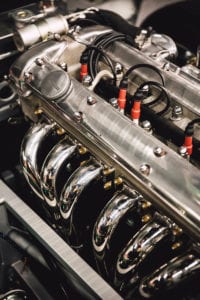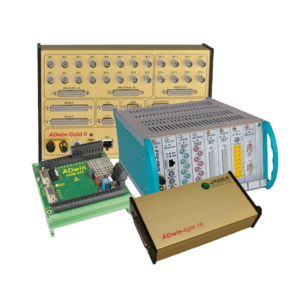Classification of Transient Duration on Contacts and Relays
ADwin Data Acquisition and Control Systems are commonly used for automotive test applications for ECUs, actuators, sensors, engines, field bus systems, and many more. In this Apps Note, CAS DataLoggers outlines a typical automotive test application for documenting that components are up to specification.
An automotive manufacturer has a switch/relay (the Device Under Test or DUT) which is mounted on a shaker test stand. Test engineers control the shaker with a programmed frequency profile in the kHz range to simulate operating conditions for the DUT. The test will typically run for several days. The purpose of the testing is to see if the switch’s contact opens over a short period of time (transient failures) or if the contacts of the switch degrade due to the vibration profile and the time duration of the test. Users are examining Resistance over Time (R over T) and peaks in the data representing events of interest.
Real-Time Signal/Waveform Generation
First users connect the ADwin test system to a lab PC. Then, using its analog outputs, ADwin stimulates the DUT with precise timing, measures the responses via analog inputs, and accurately calculates the DUT’s dynamic values online. This stimulation can be performed over a wide frequency range from a few hundred Hertz to several hundred kilohertz.
ADwin applications always run in real-time. This is due to the system design which incorporates a local CPU, additional analog and digital interfaces, and flexible expansion options. ADwin’s local CPU is a 64-bit floating-point 1GHz ZYNQ, allowing fast, deterministic program execution with a guaranteed reaction time of fewer than 500 nanoseconds. ADwin also features internal memory for executing real-time code and onboard coprocessors to allow for more demanding applications.
 ADwin Models
ADwin Models
There are three ADwin series: ADwin-light-16, ADwin-Gold-ll, and ADwin-Proll.
The ADwin-light-16 and ADwin-Gold-ll systems are compact solutions for applications with few I/O channels and limited expansion or configuration requirements. In contrast, the modular, expandable ADwin-Pro-ll system is recommended for applications with many channels and flexible configurations.
Classing of Transients
In many test applications, users apply an analog and/or digital stimulus to the DUT, using single or multiple channels of actuators or amplifiers. In addition to providing the stimulation, the ADwin system acquires the response of the components by reading its own input channels and evaluating the response in real-time. Thus, the system can immediately calculate how well the DUT matches the required specifications.
ADwin systems perform all the necessary tests and also perform post-test data analysis. Here the ADwin measures and categorizes time in classes. Classes are time period ranges (i.e. the time resolution, for example, 500 nanoseconds to 1 microsecond). In this relay test application, every sample over 7 ohms is classed as an interrupt. Users are specifically looking for all instances of this category. ADwin’s time range here is 500ns resolution to 2 milliseconds.
During acquisition, the ADwin test system checks to see if the signal is above the set level and if so, it then measures the duration and the value’s threshold. Online evaluation of measurement data is performed immediately after each sample is taken. The ADwin automatically classes the transient according to Time over Resistance (T/R)–for example, a Class 1 result indicates that the switch contact is continuously open. ADwin also manages the distribution of classes.
Test information and measurement data is transferred to a control system and displayed on the PC through a graphical user interface (GUI). This is done via an Ethernet connection. On production lines, a programmable controller is typically connected via Profibusor other Fieldbus The ADwin automatically generates a table of the data and this information can then be stored as quality records in the production database.
System Setup
Here users have a +10V stabilized regular voltage source with a resistor of 100 ohms. The test is typically performed at 100mA (milliampere).
The ADwin-PRO-COMP16 card is custom-built with a single-ended input. The classification is performed in this card itself. The card has a 10-bit ADC converter on it and 8 channels per card. The voltage range of the card can be adapted, for example from -2 to 18V.
Meanwhile, the ADwin’s T-12 processor has a counter which increments for every class. Each class can be set by software before starting the test so values don’t have to be fixed.
Test Results
ADwin’s external SDRAM stores the data. The recorded post-test data has significant value to:
- The switch/relay manufacturer
- Systems integrators
- 3rd-party Testers
ADwin Benefits
- Fast enough to measure transients
- Easy to use
- Quick development time
- ADwin systems can be configured individually in order to meet all test specifications.
For more information on ADwin Real-Time DAQ & Control Systems, automotive test systems or to find the ideal solution for your application-specific needs, contact a CAS DataLoggers Application Specialist at (800) 956-4437 or request more information.

